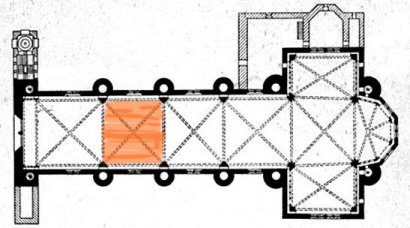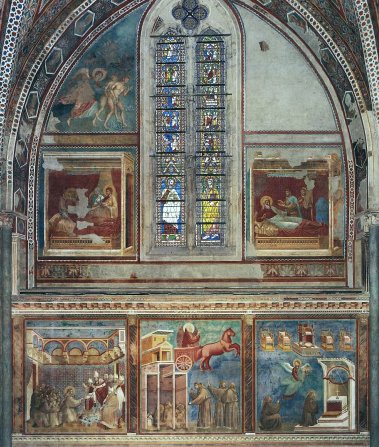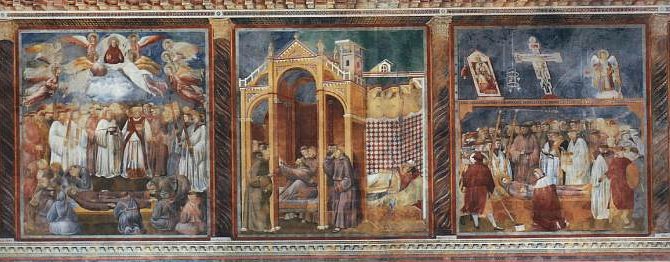|
Upper Church: Bay 2 |
|
S |
| North wall |
|
|
|
|
Old Testament scenes. Top register: Expulsion from the Garden of Eden, the labours of Adam and Eve (lost). Middle register: Isaac blesses Jacob, Esau before Isaac. Franciscan scenes: 7. Pope Innocent III approves the Franciscan rule. 8. The vision of the chariot of fire to the Friars at Rivotorto. 9.The vision of the heavenly thrones. The approval of the rule was by no means as straightforward as is suggested in the fresco: Innocent III was very conscious of the problem of heresy within the church. It seems that the approval was only given orally, though here a point is stretched as the Pope hands Francis a document, suggesting more than oral approval is being given. The strange vision of the chariot of fire is described by Bonaventure ( IV 4.) It happened to a group of Franciscan in Rivototo, just down the hill from Assisi. Bonaventure tells us that the Franciscans lived in poverty in a 'deserted hut', but here that hut has had something of a makeover; as elsewhere, the somewhat heretical notion of absolute poverty that worried Innocent III has been modified. The 'chariot of fire' is a reference to the prophet Elijah, with whom Francis is identified. The third scene is another Franciscan vision.( Bonaventura VI 6). A poor brother had a dream of splendid thrones, and wondered who they were for. A voice told him that 'This seat was that of one of the fallen angels, and is now kept for the humble Francis.' An important theme here is that of blessing. Isaac blessed Jacob by mistake, tricked by him and his wife Rebecca and taken in by those hairy hands. This contrasts with the image of the unambiguous blessing given by Pope Innocent, though as we know there were ambiguities in reality. We will see below that there are correspondences on the south wall images. |
South Wall |
|
|
|
|
| New Testament scenes. Top register:
Flight into
Egypt (mostly lost) Circumcision. Middle register: Crucifixion, the way to
Calvary. Franciscan scenes: 20. The death and ascension of Francis. 21. The apparition of Francis to Fra Agostino and to Bishop Guido of Arezzo. 22. The confirmation of the stigmata. The first of these three scenes is, it seems, something of a controversial one. Ascribing an ascension to Francis includes him in the list of those in the vault of bay 3; Christ, the Virgin Mary, and john the Baptist. It is not, however, a physical ascension, but the vision of a Monk. Bonaventura becomes most eloquent here: 'One of his brethren and disciples saw that blessed soul, under the likeliness of a star exceeding bright, borne on a dazzling cloud over many waters, mounting in a straight course to Heaven, as though it were radiant with the dazzling whiteness of his exalted sanctity, and filled with the riches of divine wisdom and grace alike'. This is not the only controversial element here. Francis's final act was a blessing, but who received it? Some say that, like Isaac on the wall opposite, he blessed the wrong man. Brother Elias was destined to become the first minister-general of the order, and should have received the blessing: instead, Francis blessed the 'firstborn', brother Bernard, the first person to join his order and a 'spiritual' Franciscan. There is a lot of Franciscan politics going on here, probably best avoided in this study: to find out more, read Early Franciscan Government: Elias to Bonaventure By Rosalind B. Brooke The second scene shows the visions of two individuals, who dreamed of the death of Francis at the moment it happened; two different events in one setting. The third scene is a match for the one opposite, where Innocent III approves the rule: this scene demonstrates the validity of the claims about the stigmata. It mirrors the story of doubting Thomas. The image also refers to the crucifixion scene above, which in its turn links with the circumcision, a prefiguring of the Christ's wound. The lost image of the Flight into Egypt can be linked to the Expulsion from Eden, though as we see, in the case of Adam and Eve they were unable to return. |
|
|




